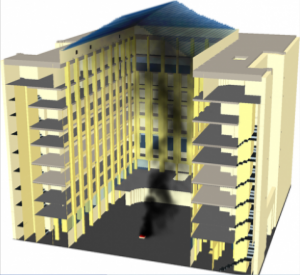SMOKE CONTROL SYSTEMS
TEC experienced staff of engineers, scientists, and technicians has earned a reputation worldwide for solving facility, corporate, and governmental smoke movement and smoke control system engineering problems with state-of- the-art scientific, engineering, and decision-analysis techniques and technologies. Computer models often play an important role during the design phase by enabling the prediction of hot smoke and toxic gas movement through a building. Our staff develops these models prior to building construction to evaluate the smoke control system’s performance. Through per construction modeling, system performance can be refined and optimized prior to the procurement and installation of equipment, often resulting in substantial cost savings.
Atria and Other Large Volume Spaces:
Computer modeling of smoke movement and control in atria and other large open spaces such as stadiums, airport terminals, and malls, has the potential to refine system requirements to reduce cost and complexity. we typically make use of both fire dynamics / CFD and timed egress models to evaluate the problem.
High-Rise Buildings:
For the pressurization smoke control systems typically designed for high-rise buildings, use of building airflow models such as CONTAM allows for the consideration of stack and wind effects, temperature effects of fire, and the impact of HVAC systems. The modeling helps to resolve the complex system of air flows and the interaction between complementary pressurization systems, such as stair pressurization, elevator shaft pressurization, and zoned smoke control.
Property Protection Systems:
Sometimes smoke control systems are designed to provide property protection versus life safety protection.


